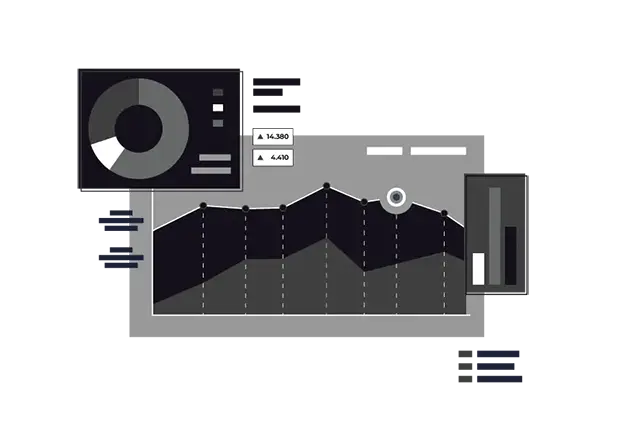

Python
Python is a versatile, high-level programming language that has become the leading tool for data science, machine learning, and scientific computing. Known for its simplicity and readability, Python's extensive ecosystem of libraries, including NumPy, Pandas, Matplotlib, and Seaborn, has made it an indispensable language for data analysis, visualization, and algorithm development. These libraries collectively provide robust functionalities that allow users to manipulate data, perform complex computations, and create high-quality visualizations, making Python a preferred choice for data scientists, researchers, and engineers.
Python
Python is a versatile, high-level programming language that has become the leading tool for data science, machine learning, and scientific computing. Known for its simplicity and readability, Python's extensive ecosystem of libraries, including NumPy, Pandas, Matplotlib, and Seaborn, has made it an indispensable language for data analysis, visualization, and algorithm development. These libraries collectively provide robust functionalities that allow users to manipulate data, perform complex computations, and create high-quality visualizations, making Python a preferred choice for data scientists, researchers, and engineers.
Mission and Vision
Python's mission is to provide a powerful yet easy-to-learn language that fosters productivity, collaboration, and innovation. The language's design philosophy emphasizes readability and simplicity, enabling users to focus on problem-solving rather than syntax complexities. The vision of Python is to be the most accessible and widely used programming language for data science, machine learning, and general-purpose programming.
The development of Python and its libraries is driven by an active global community committed to creating open-source tools that democratize access to data science. Python's ecosystem continuously evolves, with new libraries and updates that keep it at the forefront of technological advancements.
Key Features and Capabilities
Python, combined with NumPy, Pandas, Matplotlib, and Seaborn, provides a comprehensive environment for data analysis and visualization:
 NumPy: Numerical Computing with Arrays: NumPy (Numerical Python) is the foundational package for numerical computing in Python. It provides support for multi-dimensional arrays and matrices, along with a collection of mathematical functions to operate on these arrays. NumPy's array objects are faster and more memory-efficient than traditional Python lists, making it ideal for scientific calculations, data manipulation, and matrix operations.
NumPy: Numerical Computing with Arrays: NumPy (Numerical Python) is the foundational package for numerical computing in Python. It provides support for multi-dimensional arrays and matrices, along with a collection of mathematical functions to operate on these arrays. NumPy's array objects are faster and more memory-efficient than traditional Python lists, making it ideal for scientific calculations, data manipulation, and matrix operations. Pandas: Data Manipulation and Analysis: Pandas is a powerful data analysis and manipulation library built on top of NumPy. It provides data structures like DataFrames and Series that simplify the process of cleaning, transforming, and analyzing structured data. Pandas is widely used for tasks such as data wrangling, time series analysis, and statistical modeling, making it a cornerstone of data science workflows.
Pandas: Data Manipulation and Analysis: Pandas is a powerful data analysis and manipulation library built on top of NumPy. It provides data structures like DataFrames and Series that simplify the process of cleaning, transforming, and analyzing structured data. Pandas is widely used for tasks such as data wrangling, time series analysis, and statistical modeling, making it a cornerstone of data science workflows. Matplotlib: Data Visualization: Matplotlib is a comprehensive plotting library that allows users to create static, interactive, and animated visualizations in Python. It provides a wide range of plotting functions for creating line plots, scatter plots, histograms, bar charts, and more. Matplotlib's versatility and control over plot aesthetics make it an essential tool for creating publication-quality figures.
Matplotlib: Data Visualization: Matplotlib is a comprehensive plotting library that allows users to create static, interactive, and animated visualizations in Python. It provides a wide range of plotting functions for creating line plots, scatter plots, histograms, bar charts, and more. Matplotlib's versatility and control over plot aesthetics make it an essential tool for creating publication-quality figures. Seaborn: Statistical Data Visualization: Seaborn is built on top of Matplotlib and provides a high-level interface for creating attractive and informative statistical graphics. Seaborn simplifies the process of visualizing complex datasets and includes built-in themes that enhance the look of plots. It is particularly useful for creating heatmaps, violin plots, pair plots, and other advanced visualizations that highlight patterns in data.
Seaborn: Statistical Data Visualization: Seaborn is built on top of Matplotlib and provides a high-level interface for creating attractive and informative statistical graphics. Seaborn simplifies the process of visualizing complex datasets and includes built-in themes that enhance the look of plots. It is particularly useful for creating heatmaps, violin plots, pair plots, and other advanced visualizations that highlight patterns in data. Data Cleaning and Preprocessing: Python's libraries excel in data cleaning and preprocessing tasks. Pandas offers powerful functions for handling missing values, filtering data, merging datasets, and performing group operations. These capabilities are crucial for preparing data for analysis and machine learning.
Data Cleaning and Preprocessing: Python's libraries excel in data cleaning and preprocessing tasks. Pandas offers powerful functions for handling missing values, filtering data, merging datasets, and performing group operations. These capabilities are crucial for preparing data for analysis and machine learning. Statistical Analysis and Modeling: Python supports a wide range of statistical analysis techniques through libraries like SciPy, Statsmodels, and Scikit-learn. These tools allow users to perform hypothesis testing, regression analysis, and machine learning, enabling data-driven insights and predictions.
Statistical Analysis and Modeling: Python supports a wide range of statistical analysis techniques through libraries like SciPy, Statsmodels, and Scikit-learn. These tools allow users to perform hypothesis testing, regression analysis, and machine learning, enabling data-driven insights and predictions. Integration with Machine Learning and AI: Python's ecosystem includes machine learning libraries such as Scikit-learn, TensorFlow, and PyTorch, which integrate seamlessly with NumPy and Pandas. This integration supports the development of machine learning pipelines, from data preprocessing to model training and evaluation.
Integration with Machine Learning and AI: Python's ecosystem includes machine learning libraries such as Scikit-learn, TensorFlow, and PyTorch, which integrate seamlessly with NumPy and Pandas. This integration supports the development of machine learning pipelines, from data preprocessing to model training and evaluation. Interoperability with Other Tools and Languages: Python's ability to interface with other programming languages, databases, and platforms enhances its versatility. It can connect to SQL databases, call C/C++ libraries, and run on cloud computing environments, making it suitable for large-scale data processing and deployment.
Interoperability with Other Tools and Languages: Python's ability to interface with other programming languages, databases, and platforms enhances its versatility. It can connect to SQL databases, call C/C++ libraries, and run on cloud computing environments, making it suitable for large-scale data processing and deployment. Extensive Community and Resources: Python's large community contributes to its extensive documentation, tutorials, and online forums. Resources like Stack Overflow, GitHub, and Python.org provide users with access to code examples, troubleshooting advice, and the latest developments in the Python ecosystem.
Extensive Community and Resources: Python's large community contributes to its extensive documentation, tutorials, and online forums. Resources like Stack Overflow, GitHub, and Python.org provide users with access to code examples, troubleshooting advice, and the latest developments in the Python ecosystem.
Applications and Use Cases
Python's flexibility and robust ecosystem make it suitable for a wide range of applications:
 Data Science and Analytics: Python is the go-to language for data scientists due to its powerful libraries for data manipulation, analysis, and visualization. It is used for data cleaning, statistical modeling, and predictive analytics across industries.
Data Science and Analytics: Python is the go-to language for data scientists due to its powerful libraries for data manipulation, analysis, and visualization. It is used for data cleaning, statistical modeling, and predictive analytics across industries. Machine Learning and Artificial Intelligence: Python is at the heart of machine learning and AI development, providing tools for building, training, and deploying models. Its libraries support deep learning, natural language processing, and computer vision, driving advancements in automation and intelligent systems.
Machine Learning and Artificial Intelligence: Python is at the heart of machine learning and AI development, providing tools for building, training, and deploying models. Its libraries support deep learning, natural language processing, and computer vision, driving advancements in automation and intelligent systems. Scientific Research: In academia and research, Python is used for numerical simulations, data analysis, and visualization. It supports complex scientific calculations and is widely used in fields such as physics, chemistry, biology, and astronomy.
Scientific Research: In academia and research, Python is used for numerical simulations, data analysis, and visualization. It supports complex scientific calculations and is widely used in fields such as physics, chemistry, biology, and astronomy. Finance and Economics: Python is used in finance for algorithmic trading, risk management, and financial modeling. Its data analysis capabilities help analysts assess market trends, forecast economic conditions, and optimize investment strategies.
Finance and Economics: Python is used in finance for algorithmic trading, risk management, and financial modeling. Its data analysis capabilities help analysts assess market trends, forecast economic conditions, and optimize investment strategies. Healthcare and Bioinformatics: Python is used in healthcare for analyzing medical data, developing diagnostic models, and conducting genomic research. Its ability to handle large datasets and perform statistical analysis makes it valuable in bioinformatics and personalized medicine.
Healthcare and Bioinformatics: Python is used in healthcare for analyzing medical data, developing diagnostic models, and conducting genomic research. Its ability to handle large datasets and perform statistical analysis makes it valuable in bioinformatics and personalized medicine. Web Development and Automation: Python is also popular in web development, with frameworks like Django and Flask used to build data-driven web applications. Additionally, Python's scripting capabilities make it a powerful tool for automating repetitive tasks and workflows.
Web Development and Automation: Python is also popular in web development, with frameworks like Django and Flask used to build data-driven web applications. Additionally, Python's scripting capabilities make it a powerful tool for automating repetitive tasks and workflows.
Benefits of Using Python and Its Libraries
Python, combined with NumPy, Pandas, Matplotlib, and Seaborn, offers numerous advantages that make it a preferred tool for data analysis:
 Ease of Learning and Use: Python's simple syntax and readability make it accessible to beginners while being powerful enough for advanced users. This ease of learning accelerates the adoption of Python in education and industry.
Ease of Learning and Use: Python's simple syntax and readability make it accessible to beginners while being powerful enough for advanced users. This ease of learning accelerates the adoption of Python in education and industry. Versatility and Extensibility: Python's extensive library ecosystem allows it to handle a wide range of tasks, from data manipulation to machine learning. Users can extend Python's functionality by integrating third-party packages and custom code.
Versatility and Extensibility: Python's extensive library ecosystem allows it to handle a wide range of tasks, from data manipulation to machine learning. Users can extend Python's functionality by integrating third-party packages and custom code. Powerful Data Visualization: With Matplotlib and Seaborn, Python provides excellent tools for visualizing data, enabling users to create insightful graphics that effectively communicate findings.
Powerful Data Visualization: With Matplotlib and Seaborn, Python provides excellent tools for visualizing data, enabling users to create insightful graphics that effectively communicate findings. Reproducibility and Sharing: Python's open-source nature and support for reproducible workflows ensure that analyses can be easily shared, validated, and built upon by others.
Reproducibility and Sharing: Python's open-source nature and support for reproducible workflows ensure that analyses can be easily shared, validated, and built upon by others. Scalability and Performance: Python's ability to handle large datasets and perform high-performance computations, especially when combined with optimized libraries like NumPy, makes it suitable for big data applications.
Scalability and Performance: Python's ability to handle large datasets and perform high-performance computations, especially when combined with optimized libraries like NumPy, makes it suitable for big data applications. Community Support and Resources: Python's active community provides a wealth of resources, including documentation, tutorials, and forums, which help users troubleshoot issues and stay updated on best practices.
Community Support and Resources: Python's active community provides a wealth of resources, including documentation, tutorials, and forums, which help users troubleshoot issues and stay updated on best practices.
Promoting Collaboration and Open Science
Python's open-source ethos fosters collaboration and open science. Users can share code, contribute to libraries, and participate in community-driven projects on platforms like GitHub. This collaborative environment encourages knowledge sharing and accelerates the development of new tools and methodologies.
Impact on Research, Industry, and Education
Python's impact spans multiple domains, driving innovation, enhancing productivity, and advancing scientific knowledge.
 Accelerating Research: Python has transformed scientific research by providing accessible tools for data analysis and modeling. Researchers can quickly test hypotheses, visualize results, and share their findings in a reproducible manner.
Accelerating Research: Python has transformed scientific research by providing accessible tools for data analysis and modeling. Researchers can quickly test hypotheses, visualize results, and share their findings in a reproducible manner. Empowering Industry: In industry, Python supports data-driven decision-making and automation, helping companies optimize operations, improve products, and gain competitive insights.
Empowering Industry: In industry, Python supports data-driven decision-making and automation, helping companies optimize operations, improve products, and gain competitive insights. Enhancing Education: Python's simplicity makes it an ideal language for teaching programming and data science. Its use in education equips students with valuable skills that are in high demand across various fields.
Enhancing Education: Python's simplicity makes it an ideal language for teaching programming and data science. Its use in education equips students with valuable skills that are in high demand across various fields.
Conclusion
Python, along with its powerful libraries like NumPy, Pandas, Matplotlib, and Seaborn, is a cornerstone of modern data science and analytics. Its flexibility, ease of use, and extensive community support make it an essential tool for anyone working with data. Whether in academia, industry, or public policy, Python enables users to unlock the potential of data, driving innovation and making a lasting impact on society. Through continuous development and community collaboration, Python will continue to shape the future of data-driven discovery and decision-making.
Resource Library
Partnered Content Networks
© 2024 STEM Network. All rights reserved.





























